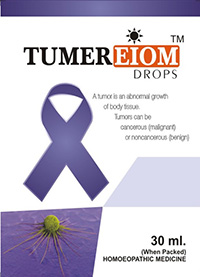TUMEREIOM™ Drops
Indication:- Helps relieve symptom of Anomalous Growths and Glandular Swellings, Breast Tumour, Mass of tissue resemblance, Metastasis of the tumours.
COMPOSITION: Baryta Carb- 6X, Scrophularia N- 2X
Packing Size: 30ml
Tumors can affect anyone – the young and old, the rich and poor, men, women and children – and represents a tremendous burden on patients, families and societies. A tumor is an abnormal growth of body tissue. Tumors can be ‘MALIGNANT’ (Cancerous) & BENIGN (Noncancerous). Most common Tumors are
(1.) ‘Breast Lumps’:- A breast lump is a localized swelling, protuberance, bulge or bump in the breast that feels different from the breast tissue around it or the breast tissue in the same area of the other breast. The majority of breast lumps are not cancerous (benign), and can have various different causes, such as infection, trauma, fibroadenoma, or fibrocystic condition of the breast. Even so, a woman who detects a breast lump should have it evaluated as soon as possible. The breast lump may feel as though it has definite borders, or like a general area of thickened tissue. The skin near the lump may become red, distended, or it may dimple.
(2.) ‘Subcutaneous Tumors’:- A lipoma is a benign tumor composed of adipose tissue (body fat). It is the most common benign form of soft tissue tumor. Lipomas are soft to the touch, usually movable, and are generally painless. Many lipomas are small (under one centimeter diameter) but can enlarge to sizes greater than six centimeters. Lipomas are commonly found in adults from 40 to 60 years of age, but can also be found in younger adults and children. Some sources claim that malignant transformation can occur, while others say this has yet to be convincingly documented. Approximately one percent of the general population has a lipoma. These tumors can occur at any age, but are most common in middle age, often appearing in people from 40 to 60 years old. Cutaneous lipomas are rare in children, but these tumors can occur as part of the inherited disease ‘Bannayan-Zonana syndrome’.
(3.) ‘Uterine Fibroid’:- A uterine fibroid is a leiomyoma (benign (non-cancerous) tumor from smooth muscle tissue) that originates from the smooth muscle layer (myometrium) of the uterus. Fibroids are often multiple and if the uterus contains too many leiomyomata to count, it is referred to as diffuse uterine leiomyomatosis. The malignant version of a fibroid is extremely uncommon and termed a leiomyosarcoma. Fibroids are the most common benign tumors in females and typically found during the middle and later reproductive years. While most fibroids are asymptomatic, they can grow and cause heavy and painful menstruation, painful sexual intercourse, and urinary frequency and urgency. Some fibroids may interfere with pregnancy although this appears to be very rare. Symptoms caused by uterine fibroids are a very frequent indication for hysterectomy. Fibroids, particularly when small, may be entirely asymptomatic. Symptoms depend on the location of the lesion and its size. Important symptoms include abnormal gynecologic hemorrhage, heavy or painful periods, abdominal discomfort or bloating, painful defecation, back ache, urinary frequency or retention, and in some cases, infertility. There may also be pain during intercourse, depending on the location of the fibroid. During pregnancy they may also be the cause of miscarriage, bleeding, premature labor, or interference with the position of the fetus.
By:- Dr. Anju Bhardwaj (Director)- Bhrigu Sons Pharmaceuticals
Recommended investigations.
(At the sole discretion of the physician OR As suggested by the physician)
- Hb (Haemoglobin)
- TLC (Total Leucocyte Count)
- DLC (Differential Leucocyte Count)
- X-Ray
- Mammography
- USG (Ultra Sonography)
- CT (Computed Tomography)
- MRI (Magnetic Resonance Imaging)
- Endoscopy
- Barium Study
- AFP (Alpha-fetoprotein)
- PSA
- CA 125 (Ovarian Cancer)
- CA 19-9 (Colon Pancreas & Breast Cancer)
- CA 30 (Hodgkin’s Disease, Lymphoma)
- CD 25 (Hairy Cell Leukemia, Lymphoma)
- Calcitonin
- Catecholamines (Pheochromocytoma)
- FNAC (Fine Needle Aspiration Cytology)
- Biopsy
- IVP (Intravenous Pyelogram)
- Cytology
